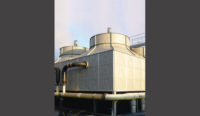Feels like it’s been a pretty good while since legionellosis found its way into the national headlines for any length of time. When a dozen people lose their lives in the most famous city in the United States, though, the culprit is going to persist past the usual 24-hour news cycle.
By now, you’ve certainly heard about the outbreak in New York. Elsewhere, a major pharmaceutical manufacturer had to shut down operations at a factory temporarily when the bacteria became an issue in one of its two cooling towers. Even more recently, it turned up in the HVAC system in a large government building in Quebec.
The respective organizations took care with the system and followed with re-testing as you would expect. And in light of the events in Manhattan, I’m sure facilities across the continent are ready to operate with an excess of caution (in the Canadian case, the level found was still substantially below local thresholds, but legionella had been identified in three separate months earlier this year in the province’s public buildings).
Human nature doesn’t want to devote a lot of attention to long-term solutions on an ongoing basis. It’s energy-intensive, and such improvements often cost money (assuming there’s not some sort of cultural disagreement about the proper fix also getting in the way). So we tend to allow any number of bad things to happen cyclically, as long as they don’t happen too frequently or do too much damage.
Which is why it is a silver lining of sorts that the freshly updated ASHRAE 188-2015, Legionellosis: Risk Management for Building Water Systems was easy for the local government to reach. The New York City Council was selective, though — adopting into law compliance with Section 7.2 of the standard. Specifically, the excerpt deals with creating and filing adequate water system management plans for a building at any stage (under construction or commissioning, new, or existing).
The State of New York followed with its own statewide emergency regulations involving planning and testing. These requirements also included the establishment of an electronic database of cooling towers, to which all owners must register their equipment.
For now, one might accentuate the positive and hope that this outbreak and swift reaction will provide a sense of urgency in other, yet-untouched municipalities and in various O&M departments. If we’re lucky, more of Standard 188 will get adopted in more places significantly faster than usual, before something else pushes the bacteria and its victims off the news scroll and off our collective radar.
Loss of an Industry Veteran
While we’re dealing with somber topics, we’d like note the recent passing of Forrest B. Fencl, chief executive of UV Resources. An ASHRAE Lifetime Fellow, Fencl had a full career focused on the application of ultraviolet germicidal irradiation (UVC) technology. In the not terribly distant past, Fencl was CEO at Steril-Aire from 1995 until 2002, when he helped to found UV Resources.
We understand he co-authored the definitive chapter for UVC in the ASHRAE handbook four different times, and he also found time to write a few feature articles for this magazine over the years, too. It’s not often that you run across someone who can both write a suitably neutral and informative feature article and also advise NASA on implementing the first solid state UVC decontamination system on the International Space Station. We will continue to admire Mr. Fencl’s expertise and dedication, and our condolences to his colleagues and family.





